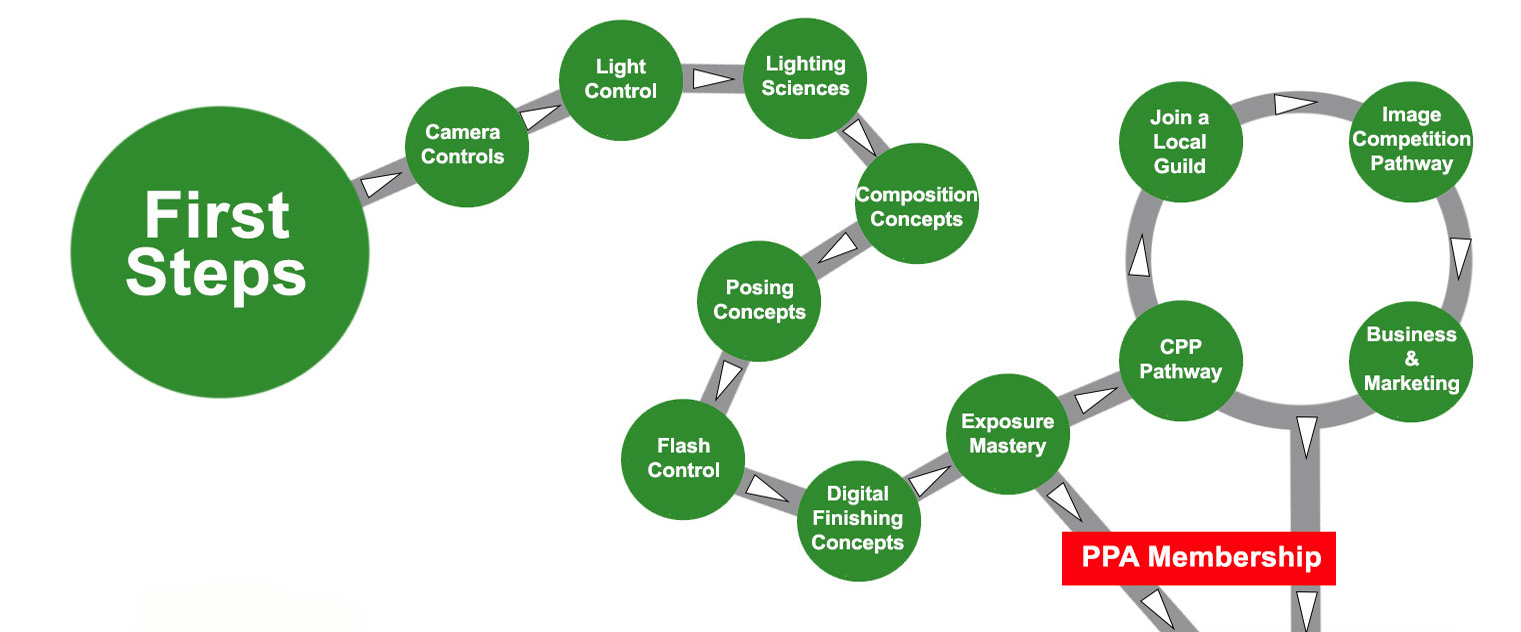Start at the Beginning
The First Steps are the perfect place to begin your journey. It is where you learn the fundamentals to build a strong foundation. Go through each of the steps one by one and work through the lessons. Follow up with the assessment tools and when you have successfully mastered the material, claim that badge.
Click on any step to learn more!

Camera Controls
The success at any level begins with a working knowledge of the fundamentals of photographic principles and a basic understanding of camera menus and exposure controls. This includes the ability to operate one’s camera in Manual Mode or to work in automatic modes with the understanding of how the photographer’s influence over these modes is needed to render proper exposures. Also, an understanding of the benefits of working in RAW verses Jpeg is encouraged. Once this level of skill has been achieved, photographers will then have a better opportunity for success as they pursue other areas of photographic interests.
Light Control
This level looks at recognizing natural lighting indoors and outdoors and finding the best source of light in these situations. Photographers should have a knowledge basic lighting patterns and of the tools and techniques for controlling natural light. In addition, photographers should be able to recognize situations that require supplemental lighting and a working knowledge of how to use it. Finally, a basic knowledge of studio lighting and basic lighting patterns is recommended.
Lighting Sciences
Since lighting is the basis in which all images are crafted, a study of the science of light and the qualities of light are in order. This includes an understanding some of the basic physics of light and a comprehension of of the various qualities of light (hard light, soft light, direct light, reflected light, etc.). In addition, photographers should gain a working knowledge of the color properties of light with a basic understanding of the Kelvin color temperature scale.
Composition Concepts
This step includes the visual aspects of image making including lens selections and the composition arts of creating an image with strong visual interests. Compositional elements include the classic concepts of image design including leading lines, repetition, framing and more. Add to this an understanding of how lens selection plays a role in depth of field, angle of view, compression and distortion as well as other important aspects of lens choice.
Posing Concepts
This step includes the visual aspects of image making including lens selections and the composition arts of creating an image with strong visual interests. Compositional elements include the classic concepts of image design including leading lines, repetition, framing and more. Add to this an understanding of how lens selection plays a role in depth of field, angle of view, compression and distortion as well as other important aspects of lens choice.
Flash Control
Photographers should have a working understanding portable flash and recognizing situations where its use is appropriate. Includes knowledge of using the flash in TTL vs manual and how to determine exposures accurately. Also, knowledge of using the flash’s adjustments to control the output of the flash and controlling the flash’s zoom head and its impact on exposures. In addition, photographers should have an understanding of the quality of light from a portable strobe and the variety of options for modifying the quality of the light.
Digital Finishing Concepts
At this level, photographers should have the skills of editing images in RAW and JPG in Photoshop, Lightroom or other imaging software. Furthermore, photographers should be able to navigate with a degree of confidence, the Lightroom or Photoshop workspace and have the skill set to use menus, tools, dialogue boxes and layers to do basic retouching, selective adjustments of exposure and enhancements and color adjustments.
Exposure Mastery
Exposure Mastery – At this level, photographers should have an understanding of metering including reflective metering and incident metering and the differences between the two. Also, a working knowledge of 18% grey and it’s place in understanding exposure. Photographers should have an understanding of the Sunny 16 rule and equivalent exposures and how changing the ISO impacts an exposure.
CPP Pathway
CPP Pathway – Begin with an understanding of the benefit of participation in the Certified Professional Photographer program and the requirements to earn the designation. Also included is the preparation of study for the written exam.
Local Guild Membership
Guild Membership: TPPA also advocates the concurrent membership and participation in the local guild structure. TPPA recognizes the vast educational opportunities and networking benefits of our local affiliated guilds throughout Texas. TPPA understands that the benefit of local guild membership enhances and compliments our own endeavors to create strong community of skilled and prosperous photographic artists. To connect to a guild near you, check out the links to the local guilds at the bottom of this page.
Image Competition Pathway
Image Competition Pathway – Begin with an understanding of the benefit of participation in image competition and the differences in the various competitions and the requirements to enter images. Also, an understanding of the judging processes and the scoring methods of various competitions is included. Also includes a study of the “12 Elements” and the beginnings of how to evaluate images and determine their appropriateness for competition.
Business and Marketing
Business and Marketing – Begin with a fundamental knowledge of getting a business up and running including: obtaining a DBA, acquiring a sales tax permit, business and equipment insurance and more. Also includes developing a solid business plan and defining a suitable target market. Other topics include creating a marketing plan and business brand and developing a social media strategy, partnering with a professional lab and creating product lines.
PPA Membership
TPPA encourages those entering the profession to also become members of Professional Photographers of America (PPA) and complete the PPA Certification program and to participate in the Merit Image Review in working towards the PPA Craftsman and Master of Photography Degrees.
Benefits include the above degree programs as well as free equipment insurance, low-cost liability insurance, the Indemnification Trust and much more. All of these are important programs and benefits for photographers who start dealing with the public and charging for their work.
First Steps
The First Steps are those studies and skill sets that one needs no matter what type of photography you wish to pursue. Simply put, these are the fundamentals of photography, camera handling, lighting, exposure, composition and digital finishing that all photographers should know and understand. These are not unique to any of the photographic disciplines, they are fundamental to ALL of the disciplines.
Notice the PPA Membership Step: TPPA encourages those entering the profession to also become members of Professional Photographers of America (PPA) and complete the PPA Certification program and to participate in the International Print Competition in working towards the PPA Craftsman and Masters Degrees.
As you begin your journey to collect the Intermediate Success Badges, we recommend joining PPA and taking advantage of the programs and benefits that they offer. Benefits include the above degree programs as well as free equipment insurance, low-cost liability insurance, the Indemnification Trust and much more. All of these are important programs and benefits for photographers who start dealing with the public and charging for their work.
